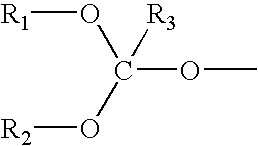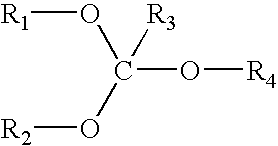Orthoester-protected polyols for low VOC coatings
a technology of orthoester protection and polyols, applied in the direction of coatings, polyurea/polyurethane coatings, etc., can solve the problems of high cost of enclosures and high productivity in the overall repair process, and achieve the effect of facilitating cross-linking through reaction
- Summary
- Abstract
- Description
- Claims
- Application Information
AI Technical Summary
Benefits of technology
Problems solved by technology
Method used
Image
Examples
example 1
Orthoester Composition A
[0074] 200 ml of HEMA / IBOA copolymer (HEMA / IBOA=37 / 63; Mn=1,700; MW=2,450) 55% solution in aromatic hydrocarbon was placed into a 0.5 liter flask equipped with a magnetic stirrer, a thermocouple, and a downward condenser. The flask was flashed with nitrogen gas, and 100 ml of 2-ethoxy-1,3-dioxalane was added. The flask was placed into a 150° C. oil bath for 1.5 hr. Then, 15 Torr vacuum was applied at 140° C. in the oil bath to remove all volatile components. After 1 hr., the flask was filled with nitrogen, and 30 ml of dry butyl acetate was added to adjust viscosity. The polymer solution was chilled down to room temperature and dispensed into an airtight container. IR spectrum of the mixture showed no significant signal from hydroxyl groups in the 3,100-3,300 cm−1 region.
example 2
[0075] 1,700 ml of HEMA / MMA / IBOA copolymer (HEMA / MMA / IBOA=22 / 15 / 63; Mn=1,490; MW=2,330) 55% solution in aromatic hydrocarbon was placed into a 2 liter flask equipped with a mechanical stirrer, a thermocouple, and a downward condenser. The flask was flashed with nitrogen gas, and 350 ml of 2-ethoxy-1,3-dioxalane was added. The flask was placed into a 150° C. oil bath for 1 hr. Then, 15 Torr vacuum was applied at 140° C. in the oil bath to remove all volatile components. After 1 hr., the flask was filled with nitrogen, and 100 ml of dry ethyl acetate was added to adjust viscosity. The polymer solution was chilled down to room temperature and dispensed into an airtight container. IR spectrum of the mixture showed no significant signal from hydroxyl groups in the 3,100-3,300 cm−1 region.
example 3
[0076] 400 ml of HEMA / IBOA copolymer (HEMA / IBOA=37 / 63; Mn=1,700; MW=2,450) 55% solution in aromatic hydrocarbon was placed into a 1 liter flask equipped with a magnetic stirrer, a thermocouple, and a downward condenser. The flask was flashed with nitrogen gas, and 400 ml of triethyl orthoformate was added. The flask was placed into a 150-170° C. oil bath for 1.5 hr. Then, 15 Torr vacuum was applied at 70° C. in the oil bath to remove all volatile components. After 1 hr., the flask was filled with nitrogen, and 30 ml of dry ethyl acetate was added to adjust viscosity. The polymer solution was chilled down to room temperature and dispensed into an airtight container. IR spectrum of the mixture showed no significant signal from hydroxyl groups in the 3,100-3,300 cm−1 region.
PUM
| Property | Measurement | Unit |
|---|---|---|
| Fraction | aaaaa | aaaaa |
| Fraction | aaaaa | aaaaa |
| Temperature | aaaaa | aaaaa |
Abstract
Description
Claims
Application Information
 Login to View More
Login to View More - R&D
- Intellectual Property
- Life Sciences
- Materials
- Tech Scout
- Unparalleled Data Quality
- Higher Quality Content
- 60% Fewer Hallucinations
Browse by: Latest US Patents, China's latest patents, Technical Efficacy Thesaurus, Application Domain, Technology Topic, Popular Technical Reports.
© 2025 PatSnap. All rights reserved.Legal|Privacy policy|Modern Slavery Act Transparency Statement|Sitemap|About US| Contact US: help@patsnap.com



